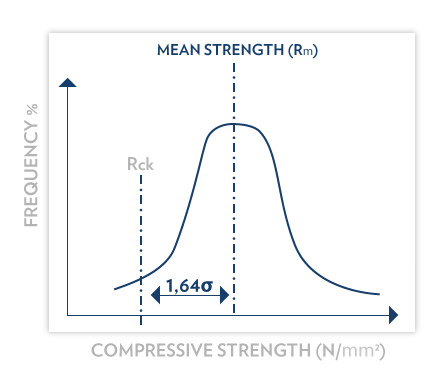Three Pillars
Concrete must be workable, strong and durable.
For this reason performance-based specifications must be provided by the project manager or site engineer to the concrete manufacturer.
The compulsory specifications are:
- Slump
- Characteristic strength
- Aggregate maximum size
- Environmental exposure class
While specific chemical admixtures and additional requests are optional.
Workability
Workability is meant as the ability of fresh concrete to flow and properly fill the formworks.Workability is measured by the slump cone (also known as Abrams cone), according to a standard testing procedure (slump test). The cone is placed on a horizontal, non-absorbent and rigid base/surface and filled up with fresh concrete in three layers, each compacted with 25 strokes of a tamping steel rod. Immediately after, the vertical difference between the top
of the mold and the displaced slumped specimen: such difference is called slump and indicates the flowing ability of concrete
Compressive Strength
STRENGHT CONTROLS
Strength is commonly used as a basis for acceptance of concrete. International standards explicitly indicate that during fresh concrete unloading many (cubic or cylindrical) samples must be taken and carefully cured in sheltered, humid condition; after 28 days these samples will be tested for compressive strength. The number and frequency of sampling usually depends on the total amount of the concrete batch and is fixed by national laws.
In case concrete specimens results not compliant with the required strength, some interventions like additional structural reinforcement may be necessary or, in worst cases, demolition of the unqualified concrete structure.
Compressive Strength
ON-SITE ACCEPTANCE CONTROLS
On site controls just before fresh concrete casting can be extremely useful in order to detect possible unsuitable concrete supply and to avoid severe problems in hardened concrete. In particular:
-
slump test can help in checking the actual workability and the possible segregation of concrete;
-
weighing the fresh concrete samples can reveal an excessive water content in the mixture (the density of concrete will result much lower than expected)
-
measurement of concrete temperature can disclose if setting already began (in this case the concrete temperature will be significantly higher compared than the environmental one).
The controls are simple and quick and can be carried out without delaying the concrete placing. In particular, weighing of concrete is a rapid operation that can be carried out on the same cubes that are prepared for 28-days strength test and that immediately gives the alarm about possible mistakes in the mixture formulation, such as the introduction of too much water, leading to a much lower strength than expected.
DURABILITY
DEFINITION
When reinforced concrete was invented in XIX Century, durability was not considered a concern at all, because the degradation processes affecting this material were still totally unknown and unforeseen. The concept of concrete durability was born just some decades ago, from the appraisal of the frequent and severe defects affecting concrete structures, and is now included in the basic requirements for structural concrete, hence it’s put at the same level of compressive strength by most of national laws. Durability is conventionally defined as the capacity of concrete to resist to environmental attack for a service life of 50-100 years (depending on the different standards) without any need of extraordinary repair works. Durability is to be achieved according to the specific place where the concrete structure will be located. i.e. in relation to the specific local environmental aggressions (the so called “environmental exposure classes”).





